Buddhas Of Bamyan
 From Nwe
From Nwe | Cultural Landscape and Archaeological Remains of the Bamyan Valley* | |
|---|---|
| UNESCO World Heritage Site | |
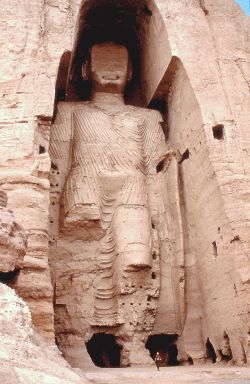 |
|
| State Party | Afghanistan |
| Type | Cultural |
| Criteria | i, ii, iii, iv, vi |
| Reference | 208 |
| Region** | Asia-Pacific |
| Inscription history | |
| Inscription | 2003 (Twenty seventh Session) |
| * Name as inscribed on World Heritage List. ** Region as classified by UNESCO. |
|
The Buddhas of Bamyan (Persian: بت های باميان - but hay-e bamiyaan) were two monumental statues of standing Buddhas carved into the side of a cliff in the Bamyan valley of central Afghanistan, situated 230 km (143 miles) northwest of Kabul at an altitude of 2500 meters (8,202 ft). Built during the sixth century, the statues represented the classic blended style of Indo-Greek art.
The main bodies were hewn directly from the sandstone cliffs, but details were modeled in mud mixed with straw, coated with stucco. This coating, practically all of which was worn away long ago, was painted to enhance the expressions of the faces, hands and folds of the robes; the larger one was painted carmine red and the smaller one was painted multiple colors.[1] The lower parts of the statues' arms were constructed from the same mud-straw mix while supported on wooden armatures. It is believed that the upper parts of their faces were made from great wooden masks or casts. The rows of holes that can be seen in photographs were spaces that held wooden pegs which served to stabilize the outer stucco.
They were intentionally dynamited and destroyed in 2001 by the Taliban, on orders from leader Mullah Mohammed Omar, after the Taliban government declared that they were "idols" (which are forbidden under Sharia law).
History
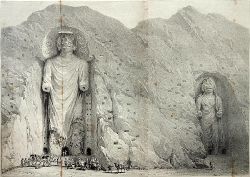
Bamyan lies on the Silk Road, a caravan route linking the markets of China with those of Western Asia. Until the eleventh century C.E., Bamyan was part of the Indian kingdom of Gandhara. It was the site of several Buddhist and Hindu monasteries, and a thriving center for religion, philosophy, and Indo-Greek art. It was a Buddhist religious site from the second century up to the time of the Islamic invasion in the ninth century.
Monks at the monasteries lived as hermits in small caves carved into the side of the Bamyan cliffs. Many of these monks embellished their caves with religious statuary and elaborate, brightly-colored frescoes.
The two most prominent statues were the giant, standing Buddhas, measuring 55 and 37 metres (180 and 121 feet) high respectively, the largest examples of standing Buddha carvings in the world. They were perhaps the most famous cultural landmarks of the region and the site was listed by UNESCO as a World Heritage Site along with the surrounding cultural landscape and archaeological remains of the Bamyan Valley. The statues were represented wearing Hellenic tunics, an echo of Alexander the Great's contribution to the Central Asian mix almost a millennium earlier.
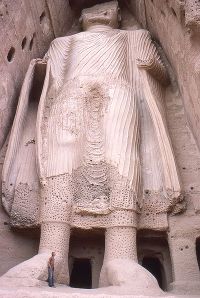
The smaller of the two statues was built in 507 C.E., the larger in 554 C.E.[2] The statues are believed to have been built by the Kushans and Indo-Hephthalites (both eastern Indo-European peoples) at the heyday of their empires. The above mentioned groups were the ancestors of the Hazaras, the most persecuted ethnic group in Afghanistan. Physical and facial features of the Hazaras are greatly similar to those in the frescoes found in the ancient relics and caves.
The Chinese Buddhist pilgrim Xuanzang passed through the area around 630 C.E. and described Bamyan as a flourishing Buddhist center "with more than ten monasteries and more than a thousand monks." He also noted that both Buddha figures were "decorated with gold and fine jewels."[3] Xuan Zang's account is intriguing as he mentions a third, even larger, reclining statue of Buddha;[1] although it is generally believed destroyed, some archaeological expeditions are searching for it.
A monumental sitting Buddha similar in style to those at Bamyan still exists in the Bingling Temple caves in China's Gansu province.
History of attacks on the Buddhas
Eleventh century to the twentieth century
When Mahmud of Ghazni (971-1030 C.E.) conquered Afghanistan and part of west India in the eleventh century, the Buddhas and frescoes were spared from destruction though Buddhist monasteries and other artifacts were looted or destroyed. Mohammed Nadir Shah (1880-1933 C.E.) fired cannon at the statues. But over the centuries the statues had largely been left untouched.
Preface to 2001, under the Taliban
In July 1999, Mullah Mohammed Omar issued a decree in favor of the preservation of the Bamyan Buddhas. Because Afghanistan's Buddhist population no longer existed, which removed the possibility of the statues being worshipped, he added: "The government considers the Bamyan statues as an example of a potential major source of income for Afghanistan from international visitors. The Taliban states that Bamyan shall not be destroyed but protected."[4]
Afghanistan's radical clerics began a campaign to crack down on "un-Islamic" segments of Afghan society. The Taliban soon banned all forms of imagery, music, and sports, including television, in accordance with what they considered a strict interpretation of Islamic law.
Information and Culture Minister Qadratullah Jamal told Associated Press of a decision by 400 religious clerics from across Afghanistan declaring the Buddhist statues against the tenets of Islam. The clerics had concluded that the statues were against Islam. The Islamist Taliban government decreed that the statues, which had survived for over 1,500 years, were idolatrous and un-Islamic.
According to UNESCO Director-General Koïchiro Matsuura, a meeting of ambassadors from the 54 member states of the Organisation of the Islamic Conference (OIC) was conducted. All OIC states - including Pakistan, Saudi Arabia, and the United Arab Emirates, three countries that officially recognized the Taliban government - joined the protest to spare the monuments.[5] A statement issued by the ministry of religious affairs of Taliban regime justified the destruction as being in accordance with Islamic law.[6] Saudi Arabia and the United Arab Emirates would later condemn the destruction.
Dynamiting and destruction, March 2001
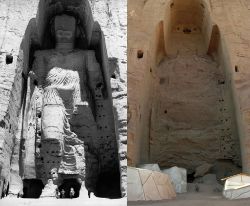
The statues were destroyed by dynamite over several weeks, starting in early March 2001, carried out in different stages. Initially, the statues were fired at for several days using anti-aircraft guns and artillery. This damaged them but did not obliterate them. Then the Taliban placed anti-tank mines at the bottom of the niches, so that when chunks of rock broke off from artillery fire, the statues would fall and be blown up again. In the end, the Taliban tied ropes around some local Hazara men, lowered them down the cliff face, and forced them to place explosives into holes in the Buddhas.[7] The two largest Buddhas faced dynamite and tank barrages and were demolished after almost a month of intensive bombardment.
On March 6, 2001 The Times quoted Mullah Mohammed Omar as stating, "Muslims should be proud of smashing idols. It has given praise to God that we have destroyed them." He had clearly changed his position from being in favor of the statues to being against them. During a March 13 interview for Japan's Mainichi Shimbun, Afghan Foreign Minister Wakil Ahmad Mutawakel stated that the destruction was anything but a retaliation against the international community for economic sanctions: "We are destroying the Buddha statues in accordance with Islamic law and it is purely a religious issue."
On March 18, The New York Times reported that a Taliban envoy said the Islamic government made its decision in a rage after a foreign delegation offered money to preserve the ancient works. The report also added, however, that other reports "have said the religious leaders were debating the move for months, and ultimately decided that the statues were idolatrous and should be obliterated."[8]
Then Taliban ambassador-at-large, Sayed Rahmatullah Hashemi, said that the destruction of the statues was carried out by the Head Council of Scholars after a single Swedish monuments expert proposed to restore the statues' heads. Hashimi is reported as saying: "When the Afghani head council asked them to provide the money to feed the children instead of fixing the statues, they refused and said, 'No, the money is just for the statues, not for the children'. Herein, they made the decision to destroy the statues." However, he did not comment on the fact that a foreign museum offered to "buy the Buddhist statues, the money from which could have been used to feed children."[9] They were upset with the lack of international humanitarian aid coming to a country ravaged by drought, earthquakes and war.[10]
On April 19, 2004, in a purported interview with Pakistani journalist Mohammad Shehzad, Mullah Mohammad Omar said the following, "I did not want to destroy the Bamyan Buddha. In fact, some foreigners came to me and said they would like to conduct the repair work of the Bamyan Buddha that had been slightly damaged due to rains. This shocked me. I thought, these callous people have no regard for thousands of living human beings — the Afghans who are dying of hunger, but they are so concerned about non-living objects like the Buddha. This was extremely deplorable. That is why I ordered its destruction. Had they come for humanitarian work, I would have never ordered the Buddhas' destruction."[11]
Aftermath of the Destruction
Commitment to rebuild
Though the figures of the two large Buddhas are almost completely destroyed, their outlines and some features are still recognizable within the recesses. It is also still possible for visitors to explore the monks' caves and the passages which connect them. As part of the international effort to rebuild Afghanistan after the Taliban war, the Government of Japan and several other organizations, among them the Afghanistan Institute in Bubendorf, Switzerland, along with the ETH in Zurich, have committed themselves to rebuilding the two largest Buddhas; anastylosis is one technique being considered.
Developments since 2002
In May 2002, a mountainside sculpture of the Buddha was carved out of a mountain in Sri Lanka. It was designed to closely resemble one of the Buddhas of Bamyan.
The Afghan government has commissioned Japanese artist Hiro Yamagata to recreate the Bamyan Buddhas using fourteen laser systems to project the images of the Buddhas onto the cliff where they once stood. The laser systems will be solar and wind-powered. The project, which will cost an estimated $9 million, is currently pending UNESCO approval. If approved, the project is estimated to be completed by June 2012.
Swiss filmmaker Christian Frei made a 95-minute documentary entitled The Giant Buddhas (released in March 2006) on the statues, the international reactions to it, and an overview of the controversy. The movie makes the controversial claim (quoting a local Afghan) that the destruction was ordered by Osama Bin Laden and that initially, Mullah Omar and the Afghans in Bamyan had opposed the destruction. Evidence of the influence exercised by bin Laden and Al-Qaeda on the Taliban has since been revealed.[12]
In the summer of 2006, Afghan officials were deciding the timetable for the re-construction of the statues. The mullahs in the province have stated that the destruction was an atrocity and the statues deserve restoration. While they wait for the Afghan government and international community to decide whether to rebuild them, a $1.3 million UNESCO-funded project is sorting out the chunks of clay and plaster—ranging from boulders weighing several tons to fragments the size of tennis balls—and sheltering them from the elements.
The Buddhist remnants at Bamyan were included on the 2008 World Monuments Watch List of the 100 Most Endangered Sites by the World Monuments Fund. It is hoped that the listing will put continued national and international attention on the site in order to ensure its long-term preservation, and to make certain that future restoration efforts maintain the authenticity of the site and that proper preservation practices are followed.
Oil painting discovery
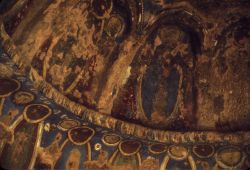
After the destruction of the Buddhas, 50 caves were revealed. In 12 of the caves wall paintings were discovered.[13] In December 2004, Japanese researchers discovered that the wall paintings at Bamyan were actually painted between the fifth and the ninth centuries, rather than the sixth to eighth centuries as previously believed. The discovery was made by analyzing radioactive isotopes contained in straw fibers found beneath the paintings. It is believed that the paintings were done by artists traveling on the Silk Road, the trade route between China and the West.[14] However, the press release picked up by media, clearly misdates the earliest uses of oil paint in Europe, which may date back to the Ancient Romans.[15]
Scientists from the National Research Institute for Cultural Properties in Tokyo (Japan), the Centre of Research and Restoration of the French Museums-CNRS (France), the Getty Conservation Institute (United States) and the ESRF (the European Synchrotron radiation facility) in Grenoble analyzed samples from the paintings,[16] typically less than 1 mm across.[17] They discovered that the paint contained pigments such as vermilion (red mercury sulfide) and lead white (lead carbonate). These were mixed with a range of binders, including natural resins, gums (possibly animal skin glue or egg)[17] and oils, probably derived from walnuts or poppies. Specifically, researchers identified drying oils from murals showing Buddhas in vermilion robes sitting cross-legged amid palm leaves and mythical creatures as being painted in the middle of the seventh century.[14]
Some have cautioned that the oils may in fact be contamination from fingers, as the touching of the painting is encouraged in Buddhist tradition. However analysis by spectroscopy and chromatography indicates an unambiguous signal for the use of oils rather than any other contaminant. In addition oils were discovered underneath other layers of paint, negating the presence of surface contaminants.[17]
Another giant statue unearthed
On 8 September 2008, archaeologists searching for a legendary 300-metre statue at the site announced the discovery of parts of an unknown 19-meter (62 ft) reclining Buddha, a pose representing Buddha's Parinirvana.[18]
Restoration
The UNESCO Expert Working Group on Afghan cultural projects convened to discuss what to do about the two statues between 3–4 March 2011 in Paris. Researcher Erwin Emmerling of Technical University Munich announced he believed it would be possible to restore the smaller statue using an organic silicon compound.[19] The Paris conference issued a list of 39 recommendations for the safeguarding of the Bamiyan site. These included leaving the larger Western niche empty as a monument to the destruction of the Buddhas, a feasibility study into the rebuilding of the Eastern Buddha, and the construction of a central museum and several smaller site museums.[20] Work has since begun on restoring the Buddhas using the process of anastylosis, where original elements are combined with modern material. It is estimated that roughly half the pieces of the Buddhas can be put back together according to Bert Praxenthaler, a German art historian and sculptor involved in the restoration. The restoration of the caves and Buddhas has also involved training and employing local people as stone carvers.[21] The project, which also aims to encourage tourism to the area, is being organized by UNESCO and the International Council on Monuments and Sites (ICOMOS).
The work has come under some criticism. It is felt by some, such as human rights activist Abdullah Hamadi, that the empty niches should be left as monuments to the fanaticism of the Taliban, while NPR reported that others believe the money could be better spent on housing and electricity for the region.[22]
Rise of Buddhas with 3D light projection
After fourteen years, on June 7, 2015, a Chinese adventurist couple Xinyu Zhang and Hong Liang filled the empty cavities where the Buddhas once stood with 3D laser light projection technology. The projector used for the installation, worth approximately $120,000, was donated by Xinyu and Hong, who were saddened by the destruction of the statues. With the desire of paying tribute, they requested permission from UNESCO and the Afghan government to do the project. About 150 local people came out to see the unveiling of the holographic statues.[23]
Notes
- ↑ 1.0 1.1 Carlotta Gall, From Ruins of Afghan Buddhas, a History Grows The New York Times, December 6, 2006. Retrieved November 8, 2019.
- ↑ Carlotta Gall, Afghans consider rebuilding Bamyan Buddhas The New York Times, November 5, 2006. Retrieved November 8, 2019.
- ↑ Sally Hovey Wriggins, Xuanzang: A Buddhist Pilgrim on the Silk Road (Boulder: Westview Press, 1996).
- ↑ Luke Harding, "On Monday Afghanistan's Taliban rulers were promising to safeguard the country's historic treasures. On Thursday they started shelling them. Luke Harding explains what changed their minds." How the Buddha got his wounds The Guardian, March 3, 2001. Retrieved November 8, 2019.
- ↑ Eleanor Boggs, Unesco Takes on the Taliban: The Fight to Save the Buddhas of Bamiyan Virginia Tech Undergraduate Historical Review. 5(1) (2017). Retrieved November 8, 2019.
- ↑ Destruction of Giant Buddhas Confirmed Agence France-Presse. Retrieved November 8, 2019.
- ↑ Matthew Power, Rebuilding the Bamiyan Buddhas Slate Magazine, July 23, 2004. Retrieved November 8, 2019.
- ↑ Barbara Crossette, Taliban Explains Buddha Demolition The New York Times, March 19, 2001. Retrieved November 8, 2019.
- ↑ Sahar Kassaimah, Afghani Ambassador Speaks At USC Islam Online, March 12, 2001. Retrieved November 8, 2019.
- ↑ W.L. Rathje, Why the Taliban are destroying Buddhas USA Today, March 22, 2001. Retrieved November 8, 2019.
- ↑ Mullah Omar, The Rediff Interview Rediff, April 12, 2004. Retrieved November 8, 2019.
- ↑ Osama’s fingerprints seen on ruins of Bamiyan Buddhas Dawn, October 23, 2006. Retrieved November 8, 2019.
- ↑ World's oldest oil paintings in Afghanistan Reuters, April 22, 2008. Retrieved November 8, 2019.
- ↑ 14.0 14.1 Roger Highfield, Oil painting 'invented in Asia, not Europe' The Telegraph, April 22, 2008. Retrieved November 8, 2019.
- ↑ Rutherford John Gettens and George Leslie Stout, Painting Materials: A Short Encyclopedia (Courier Dover Publications, 2011, ISBN 0486215970).
- ↑ Ancient Buddhist Paintings From Bamiyan Were Made Of Oil, Hundreds Of Years Before Technique Was 'Invented' In Europe Science Daily, April 22, 2008. Retrieved November 8, 2019.
- ↑ 17.0 17.1 17.2 Philip Ball, Ancient Buddhas painted in oils Nature, April 22, 2008. Retrieved November 8, 2019.
- ↑ New Bamiyan Buddha find amid destruction, Agence France-Presse, November 8, 2008. Retrieved November 8, 2019.
- ↑ Researchers Say They Can Restore 1 of Destroyed Bamiyan Buddhas AOL News], March 1, 2011. Retrieved November 8, 2019.
- ↑ Expert Working Group releases recommendations for Safeguarding Bamiyan UNESCO, April 27, 2011. Retrieved November 8, 2019.
- ↑ Emma Graham-Harison, Stone carvers defy Taliban to return to the Bamiyan valley The Guardian, May 16, 2012. Retrieved November 8, 2019.
- ↑ Joanna Kakissis, Bit By Bit, Afghanistan Rebuilds Buddhist Statues National Public Radio, July 27, 2011. Retrieved November 8, 2019.
- ↑ Mary-Ann Russon, Afghanistan: Buddhas of Bamiyan resurrected as laser projections International Business Times, June 12, 2015. Retrieved November 8, 2019.
References
ISBN links support NWE through referral fees
- Gaulier, Simone, Robert Jera-Bezard, and Maillard M. Buddhism in Afghanistan and Central Asia: Introduction to Religions Section 13 - Indian Religions, No 1 (Iconography of Religions) Brill Academic Pub., 1976. ISBN 978-9004047464
- Gettens, Rutherford John, and George Leslie Stout. Painting Materials: A Short Encyclopedia. Courier Dover Publications, 2011. ISBN 0486215970
- Maniscalco, Fabio. World Heritage and War, monographic series "Mediterraneum," vol. 6, Naples, Massa Publisher, 2007. Retrieved April 30, 2020.
- Rutherford, John Gettens and George Leslie Stout. Painting Materials: A Short Encyclopedia. Courier Dover Publications, 1966. ISBN 0486215970
- Wriggins, Sally Hovey. Xuanzang: A Buddhist Pilgrim on the Silk Road. Boulder: Westview Press, 1996. ISBN 978-0813334073
External links
All links retrieved February 17, 2022.
- Bamian Buddha Statues and Theosophy
- Artist to recreate Afghan Buddhas. BBC News, 9 August 2005.
- "The Giant Buddhas" trilingual site (English, Deutsch, Français) - a film about the destruction of the giant statues. By Christian Frei, Switzerland (2005).
- The Giant Buddhas at the Internet Movie Database
- Harding, Luke. How the Buddha got his wounds, The Guardian, March 3 2001.
Credits
New World Encyclopedia writers and editors rewrote and completed the Wikipedia article in accordance with New World Encyclopedia standards. This article abides by terms of the Creative Commons CC-by-sa 3.0 License (CC-by-sa), which may be used and disseminated with proper attribution. Credit is due under the terms of this license that can reference both the New World Encyclopedia contributors and the selfless volunteer contributors of the Wikimedia Foundation. To cite this article click here for a list of acceptable citing formats.The history of earlier contributions by wikipedians is accessible to researchers here:
- Buddhas of Bamyan history
The history of this article since it was imported to New World Encyclopedia:
- History of "Buddhas of Bamyan"
Note: Some restrictions may apply to use of individual images which are separately licensed.
↧ Download as ZWI file | Last modified: 02/03/2023 20:45:25 | 39 views
☰ Source: https://www.newworldencyclopedia.org/entry/Buddhas_of_Bamyan | License: CC BY-SA 3.0
 ZWI signed:
ZWI signed: KSF
KSF